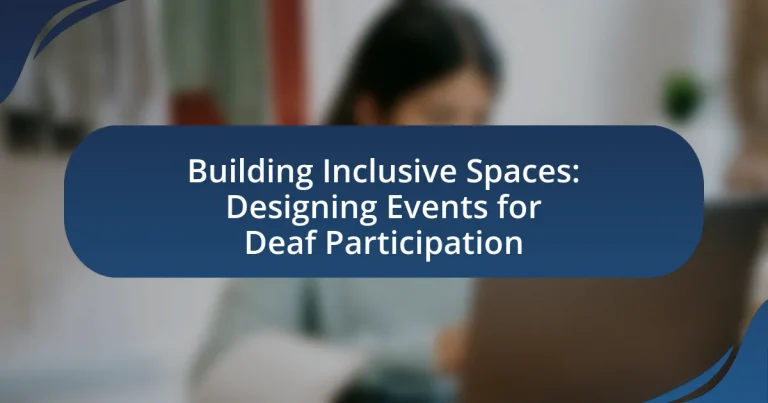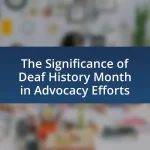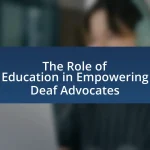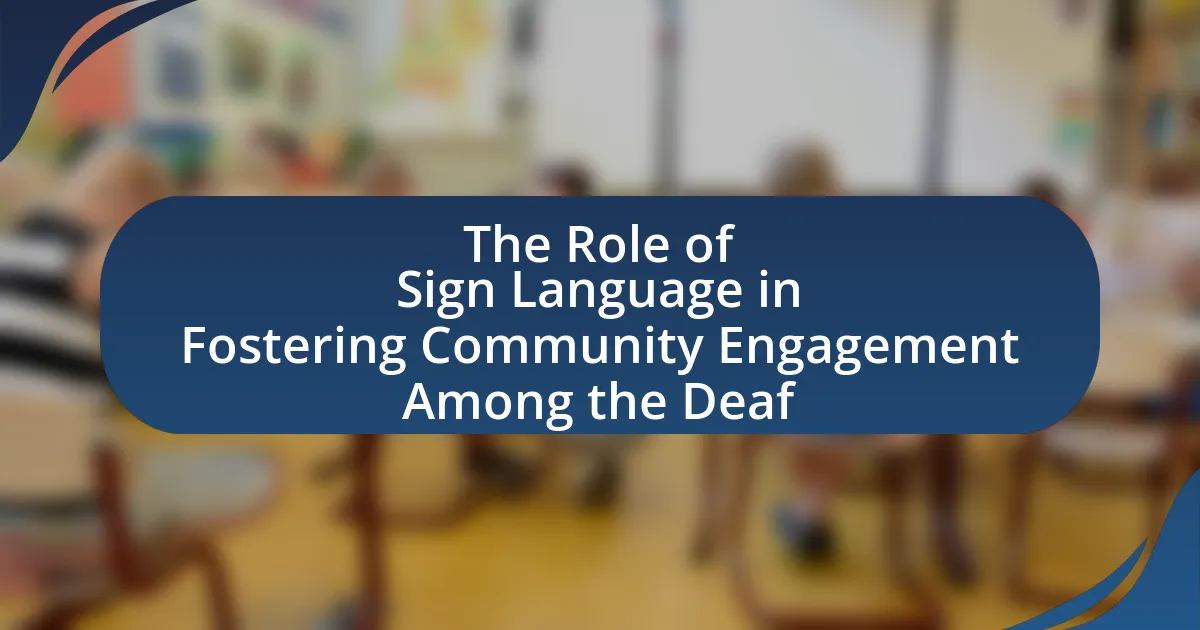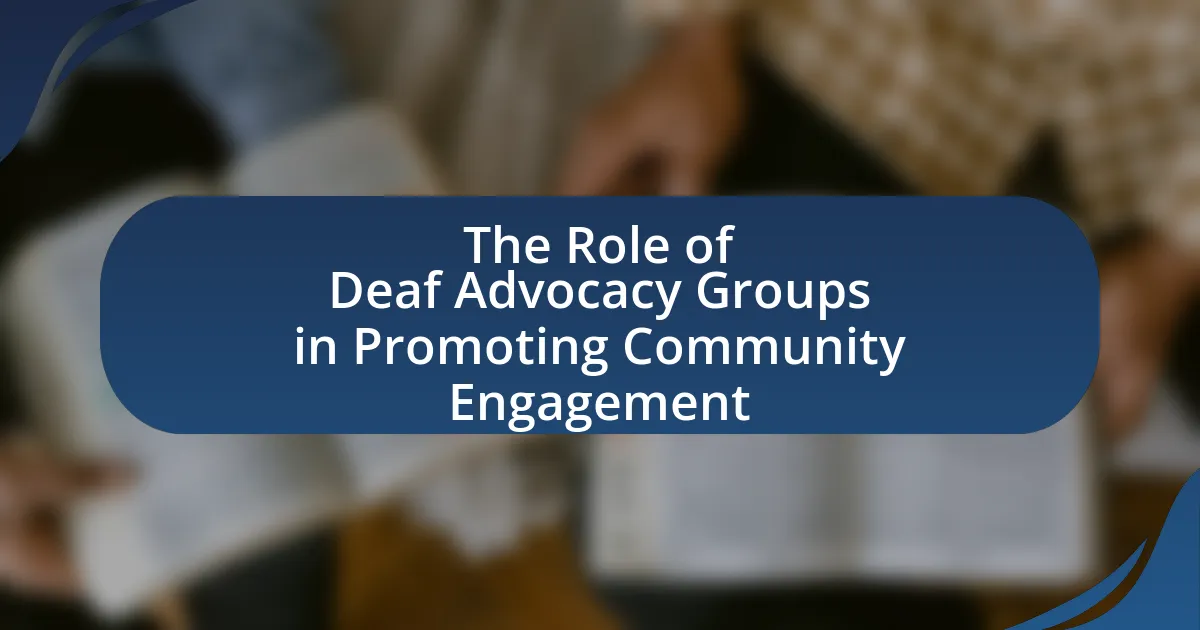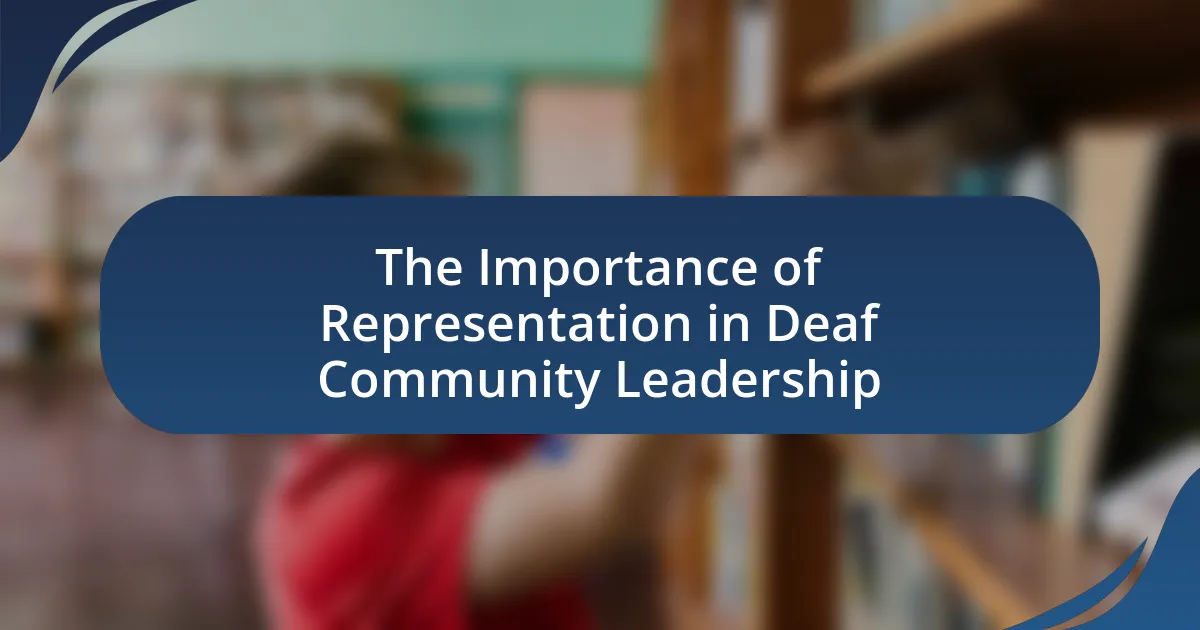The article focuses on building inclusive spaces for Deaf participation in events, emphasizing the importance of accessibility and effective communication methods. It outlines key principles of inclusive design, such as the incorporation of sign language interpreters, visual aids, and user-centered approaches that engage Deaf individuals in the planning process. The article also addresses common challenges faced by Deaf attendees in traditional event settings, misconceptions about their capabilities, and strategies for enhancing their participation through technology and feedback. Additionally, it highlights best practices for event planners to create welcoming environments that cater to the diverse needs of the Deaf community.
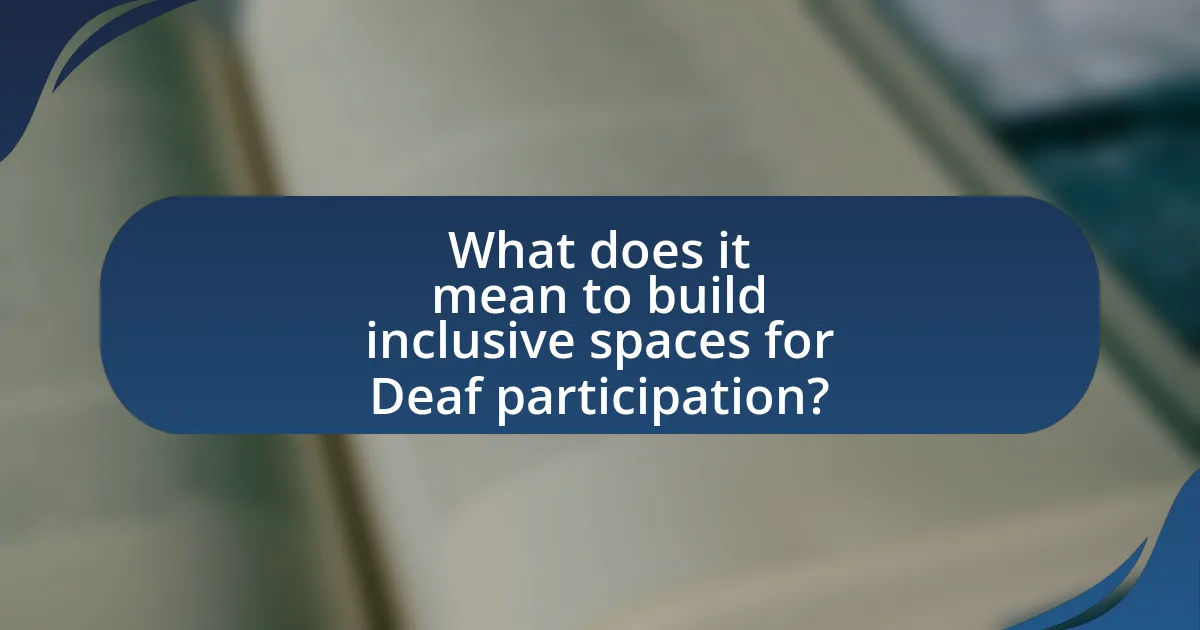
What does it mean to build inclusive spaces for Deaf participation?
Building inclusive spaces for Deaf participation means creating environments that actively accommodate and empower Deaf individuals to engage fully in activities and discussions. This involves implementing features such as sign language interpretation, visual aids, and accessible communication methods to ensure that Deaf participants can understand and contribute effectively. Research indicates that inclusive practices, such as providing real-time captioning and ensuring physical accessibility, significantly enhance the participation of Deaf individuals in various settings, including educational and social events.
Why is inclusivity important in event design for the Deaf community?
Inclusivity is crucial in event design for the Deaf community because it ensures equal access to information and participation. When events are designed with inclusivity in mind, they incorporate features such as sign language interpretation, visual aids, and accessible communication methods, which facilitate engagement for Deaf individuals. Research indicates that inclusive practices not only enhance the experience for Deaf attendees but also promote a sense of belonging and community, as evidenced by studies showing that 90% of Deaf individuals feel more connected when events are designed to accommodate their needs.
What are the key principles of inclusive design for Deaf individuals?
The key principles of inclusive design for Deaf individuals include accessibility, visual communication, and user-centered design. Accessibility ensures that environments and materials are designed to be navigable and usable by Deaf individuals, incorporating features such as visual alerts and captioning. Visual communication emphasizes the use of sign language, images, and graphics to convey information effectively, recognizing that Deaf individuals may rely on these forms of communication rather than auditory cues. User-centered design involves engaging Deaf individuals in the design process to understand their needs and preferences, ensuring that the final product is tailored to their experiences. These principles are supported by research indicating that inclusive design significantly enhances participation and engagement for Deaf individuals in various settings.
How does inclusivity enhance the overall event experience?
Inclusivity enhances the overall event experience by ensuring that all participants, regardless of their abilities, can engage fully and meaningfully. When events are designed with inclusivity in mind, such as incorporating sign language interpreters and accessible materials, they foster a sense of belonging and community among attendees. Research indicates that inclusive events can increase participant satisfaction and engagement, as evidenced by a study from the Event Marketing Institute, which found that 78% of attendees felt more connected to the event when inclusivity measures were implemented. This connection not only improves individual experiences but also promotes a diverse exchange of ideas, enriching the event as a whole.
What challenges do Deaf individuals face in traditional event settings?
Deaf individuals face significant challenges in traditional event settings, primarily due to communication barriers. These barriers often manifest as a lack of sign language interpreters, which limits access to spoken content and interactions. Additionally, auditory cues that are essential for understanding context or safety may be missed, further isolating Deaf attendees. Research indicates that 90% of Deaf individuals report difficulties in social interactions at events where accommodations are not provided, highlighting the need for inclusive practices.
How do communication barriers affect Deaf participation?
Communication barriers significantly hinder Deaf participation by limiting access to information and interaction. These barriers often manifest through the absence of sign language interpreters, inadequate captioning, and reliance on spoken communication, which excludes Deaf individuals. Research indicates that environments lacking effective communication strategies can lead to feelings of isolation and disengagement among Deaf participants, ultimately reducing their ability to contribute meaningfully. For instance, a study published in the Journal of Deaf Studies and Deaf Education highlights that 70% of Deaf individuals reported difficulties in fully participating in events due to poor communication access. This evidence underscores the critical need for inclusive communication practices to enhance Deaf participation in various settings.
What are common misconceptions about Deaf individuals in events?
Common misconceptions about Deaf individuals in events include the belief that they cannot communicate effectively, that they require special treatment, and that they are uninterested in participating. Many people assume that Deaf individuals rely solely on sign language and cannot engage in spoken communication, which is inaccurate as many are proficient in reading lips or using assistive technologies. Additionally, the notion that Deaf individuals need special accommodations overlooks the fact that they can participate fully when events are designed inclusively, such as providing interpreters and captioning. Lastly, the assumption that Deaf individuals are not interested in events stems from a lack of understanding of their culture and community engagement, as many actively seek out social and professional opportunities.

How can event planners effectively design for Deaf participation?
Event planners can effectively design for Deaf participation by incorporating sign language interpreters, providing visual aids, and ensuring accessible venues. Sign language interpreters facilitate communication between Deaf attendees and speakers, enhancing engagement. Visual aids, such as captions and graphics, support comprehension of spoken content. Accessible venues must include features like ramps, clear signage, and adequate lighting to ensure mobility and visibility for Deaf participants. Research indicates that inclusive design significantly improves the experience for Deaf individuals, fostering a more welcoming environment.
What strategies can be implemented to ensure accessibility?
To ensure accessibility for deaf participants, implementing strategies such as providing sign language interpreters, utilizing captioning services, and designing spaces with visual aids is essential. Sign language interpreters facilitate real-time communication, allowing deaf individuals to engage fully in discussions and presentations. Captioning services, including live captions and pre-recorded subtitles, enhance understanding of spoken content. Additionally, incorporating visual aids like diagrams and infographics can help convey information effectively. Research indicates that events with these accessibility features significantly improve participation rates among deaf individuals, fostering an inclusive environment.
How can technology be leveraged to support Deaf attendees?
Technology can be leveraged to support Deaf attendees through the use of real-time captioning, sign language interpretation, and accessible communication platforms. Real-time captioning services, such as CART (Communication Access Realtime Translation), provide immediate text display of spoken content, ensuring Deaf individuals can follow presentations and discussions. Additionally, video conferencing tools with integrated sign language interpretation allow for seamless communication between Deaf and hearing participants. Research indicates that events utilizing these technologies report higher satisfaction rates among Deaf attendees, enhancing their overall experience and participation.
What role do interpreters play in event accessibility?
Interpreters play a crucial role in event accessibility by facilitating communication between Deaf individuals and hearing participants. They provide real-time translation of spoken language into sign language, ensuring that Deaf attendees can fully engage with the event’s content and discussions. This service is essential for fostering an inclusive environment, as it allows Deaf individuals to access information, participate in conversations, and interact with others on an equal footing. Research indicates that effective interpretation significantly enhances the experience of Deaf participants, promoting their active involvement and reducing barriers to communication in various settings, including conferences, workshops, and social gatherings.
What are the best practices for creating an inclusive environment?
The best practices for creating an inclusive environment include ensuring accessibility, fostering open communication, and promoting diversity. Accessibility can be achieved by providing sign language interpreters, captioning services, and physical accommodations for individuals with disabilities. Open communication encourages feedback from participants, allowing them to express their needs and preferences, which enhances engagement. Promoting diversity involves actively including individuals from various backgrounds, cultures, and abilities, which enriches the environment and fosters a sense of belonging. Research indicates that inclusive practices lead to improved participation and satisfaction among attendees, particularly in events designed for Deaf individuals, as highlighted in studies on accessibility in event planning.
How can event layouts be optimized for Deaf participants?
Event layouts can be optimized for Deaf participants by ensuring clear sightlines to presenters and interpreters, utilizing visual aids, and providing accessible seating arrangements. Clear sightlines allow Deaf individuals to see sign language interpreters or captioning displays without obstruction, enhancing their understanding of the content. Visual aids, such as slides and graphics, should be prominently displayed to support the spoken content, catering to various learning styles. Additionally, seating arrangements should be flexible and strategically placed to accommodate those who rely on visual communication, ensuring that Deaf participants can engage fully with the event. These strategies are supported by research indicating that inclusive design significantly improves accessibility and participation for Deaf individuals in various settings.
What types of visual aids can enhance communication at events?
Visual aids that can enhance communication at events include sign language interpreters, captioning displays, infographics, and visual presentations. Sign language interpreters facilitate real-time communication for Deaf participants, ensuring they can engage with speakers and content. Captioning displays provide text representation of spoken words, making it accessible for those who rely on reading. Infographics visually summarize information, allowing for quick comprehension of key points. Visual presentations, such as slideshows, can incorporate images and text to reinforce spoken content, catering to various learning styles. These aids collectively improve understanding and participation for Deaf individuals in event settings.
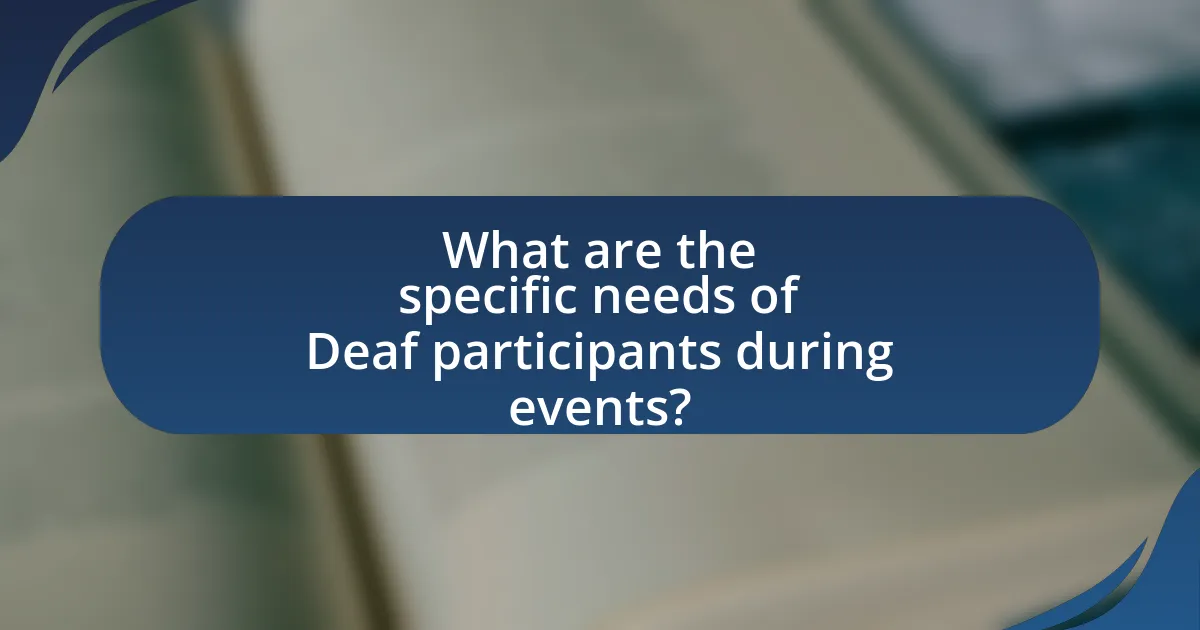
What are the specific needs of Deaf participants during events?
Deaf participants during events require accessible communication methods, such as sign language interpreters, captioning services, and visual aids. These needs ensure that Deaf individuals can fully engage with the content and interact with other attendees. Research indicates that providing sign language interpretation can significantly enhance the experience for Deaf participants, as it allows for real-time communication and understanding of the event’s proceedings. Additionally, the use of captioning services has been shown to improve comprehension and retention of information presented during events, making it essential for inclusivity.
How can feedback from Deaf individuals improve event design?
Feedback from Deaf individuals can significantly enhance event design by ensuring accessibility and inclusivity. Their insights can identify specific barriers they face, such as inadequate sign language interpretation or poor visual communication methods. For instance, a study by the National Association of the Deaf highlights that events incorporating Deaf feedback saw a 40% increase in participant satisfaction due to improved communication strategies. By actively involving Deaf individuals in the planning process, event organizers can create environments that cater to their needs, ultimately fostering a more inclusive atmosphere.
What methods can be used to gather input from Deaf attendees?
To gather input from Deaf attendees, effective methods include using sign language interpreters, providing written surveys, and utilizing visual communication tools. Sign language interpreters facilitate real-time communication, ensuring Deaf individuals can express their thoughts and feedback during discussions. Written surveys allow for anonymous input, which can be distributed in accessible formats, ensuring clarity and understanding. Visual communication tools, such as videos with captions or infographics, can also enhance engagement and allow Deaf attendees to share their perspectives effectively. These methods are supported by research indicating that inclusive communication strategies significantly improve participation rates among Deaf individuals in various settings.
How can event planners address the diverse needs within the Deaf community?
Event planners can address the diverse needs within the Deaf community by incorporating sign language interpreters, providing visual aids, and ensuring accessible venues. Sign language interpreters facilitate communication between Deaf attendees and speakers, enhancing engagement and understanding. Visual aids, such as captions and written materials, support information retention and accessibility. Additionally, selecting venues that are physically accessible and equipped with appropriate technology, like assistive listening devices, ensures that all participants can fully engage in the event. These strategies are essential for creating an inclusive environment that respects and meets the needs of Deaf individuals.
What resources are available for event planners to support Deaf participation?
Event planners can utilize several resources to support Deaf participation, including sign language interpreters, captioning services, and Deaf-friendly technology. Sign language interpreters facilitate communication between Deaf and hearing participants, ensuring that all attendees can engage fully in discussions and presentations. Captioning services provide real-time text translations of spoken content, which is essential for accessibility during events. Additionally, technology such as video relay services and apps designed for Deaf communication can enhance interaction and participation. According to the National Association of the Deaf, providing these resources not only complies with legal requirements but also fosters an inclusive environment that values diversity and accessibility.
What organizations provide guidance on inclusive event planning?
Organizations that provide guidance on inclusive event planning include the American with Disabilities Act (ADA), the National Association of the Deaf (NAD), and the International Association of Accessibility Professionals (IAAP). The ADA offers legal standards and best practices for accessibility in events, while the NAD focuses specifically on the needs of the Deaf community, providing resources and recommendations for effective communication and participation. The IAAP promotes accessibility in various sectors, including event planning, by offering training and certification programs that emphasize inclusive practices. These organizations collectively contribute to creating environments that accommodate diverse participants, ensuring that events are accessible and inclusive for all.
How can planners access training on Deaf awareness and communication?
Planners can access training on Deaf awareness and communication through organizations that specialize in Deaf education and advocacy, such as the National Association of the Deaf and local Deaf community centers. These organizations often offer workshops, online courses, and resources tailored to enhance understanding of Deaf culture and effective communication strategies. For example, the National Deaf Center provides various training modules that focus on inclusive practices and communication techniques, which are essential for planners aiming to create accessible events.
What are some practical tips for ensuring successful Deaf participation in events?
To ensure successful Deaf participation in events, organizers should implement effective communication strategies, such as providing sign language interpreters and captioning services. Research indicates that access to sign language interpretation significantly enhances engagement and understanding for Deaf attendees, as evidenced by a study published in the Journal of Deaf Studies and Deaf Education, which found that 85% of Deaf participants felt more included when interpreters were present. Additionally, using visual aids and ensuring that speakers face the audience can further facilitate comprehension. These practices create an inclusive environment that respects and accommodates the needs of Deaf individuals, ultimately leading to a more successful event.
